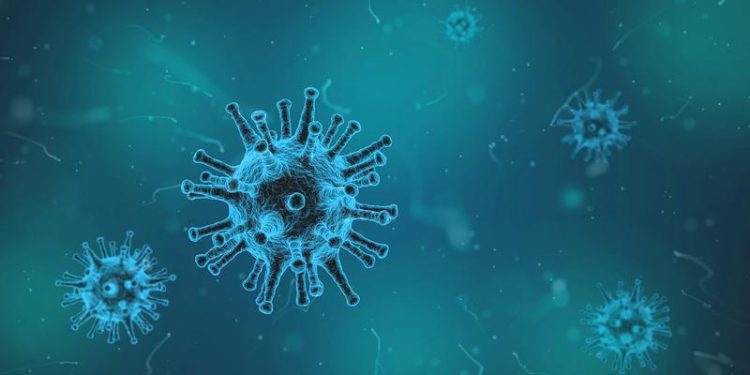How herpesviruses win the footrace against the immune system

Illustration of virus particles. Pixabay
Bacteria and viruses continuously challenge the immune system. They reach the body by inhalation or via host contact with saliva, blood, or other secretions, but upon entry, the immune system recognises and fights these pathogens through a variety of mechanisms. In most cases, the immune system successfully brings the infection under control and eliminates the pathogen.
However, one virus family is superbly adapted to the immune system and cannot be eliminated: the herpesviruses. Infection is for life. A research team at the Helmholtz Centre for Infection Research (HZI) has identified a herpesvirus protein that specifically shuts off the immune response, enabling the virus to establish lifelong infection in the body. The results will be published in the journal PLOS Pathogens on 25 May 2017.
Herpesviruses have coexisted with humans for millions of years, and during this time they have developed elegant strategies to escape immune system control. An important representative of the herpesvirus family is cytomegalovirus (CMV) – about half of the German population carries this virus.
“Acute CMV infection of a woman during pregnancy is a huge danger for the infant in the womb. During pregnancy, CMV can be transmitted to the fetus and cause serious and lifelong damage including deafness and microcephaly,” says Prof Melanie Brinkmann, who has led the junior research group “Viral Immune Modulation” at the HZI since 2010. To date, no vaccine against CMV is available, in part because the mechanisms used by this virus to weaken the immune response are not fully understood. “To successfully fight CMV infection, we need a detailed understanding of the switches flipped by this virus to outsmart our immune system,” says Brinkmann.
As part of the Helmholtz Virtual Institute “Viral Strategies of Immune Evasion” (VISTRIE), the Brinkmann research group used an unbiased screen of CMV proteins to identify viral inhibitors of the immune response. They found a poorly characterised CMV protein that is able to incapacitate the antiviral immune response just a few minutes after infection. During infection, this protein, named M35, is introduced directly into a target host cell with the virus particle itself.
In infected cells, it precisely controls the nucleus – the cellular control centre – where it blocks the antiviral immune response. By means of genetically modified viruses the researchers found in mice that the immune system is more adept at controlling CMV infection when M35 is absent from the virus particle.
“Our work shows that immediately after entry in the host species, CMV takes action to mitigate the immune response”, says Melanie Brinkmann. “It is a race against time that CMV unequivocally wins. We have shown that the M35 protein is essential for CMV to win this competition. Thus, it provides a crucial contribution to the strategy used by this virus to establish a lifelong infection in its host.”
In collaboration with researchers at the HZI and the Hannover Medical School (MHH), Brinkmann’s team now plans to further characterise the mechanism of the M35 protein. In the future, specific inhibitors that block the function of M35 may become promising antiviral substances for the treatment of CMV infection.
Original publication:
B. Chan, V. Gonçalves Magalhães, N.A.W. Lemmermann, V. Juranić Lisnić, M. Stempel, K.A. Bussey, E. Reimer, J. Podlech, S. Lienenklaus, M.J. Reddehase, S. Jonjić, M.M. Brinkmann: The murine cytomegalovirus M35 protein antagonizes type I IFN induction downstream of pattern recognition receptors by targeting NF-κB mediated transcription. PLOS Pathogens, 2017, http://journals.plos.org/plospathogens/article?id=10.1371/journal.ppat.1006382
The press release and a picture are available on our website: https://www.helmholtz-hzi.de/en/news_events/news/view/article/complete/how_herpe…
Helmholtz Centre for Infection Research:
Scientists at the Helmholtz Centre for Infection Research (HZI) in Braunschweig, Germany, are engaged in the study of different mechanisms of infection and of the body’s response to infection. Helping to improve the scientific community’s understanding of a given bacterium’s or virus’ pathogenicity is key to developing effective new treatments and vaccines. http://www.helmholtz-hzi.de/en
Contact:
Susanne Thiele, Press Officer
susanne.thiele@helmholtz-hzi.de
Helmholtz Centre for Infection Research
Press and Communications
Inhoffenstr. 7
D-38124 Braunschweig
Germany
Phone: +49 531 6181-1404
Media Contact
All latest news from the category: Life Sciences and Chemistry
Articles and reports from the Life Sciences and chemistry area deal with applied and basic research into modern biology, chemistry and human medicine.
Valuable information can be found on a range of life sciences fields including bacteriology, biochemistry, bionics, bioinformatics, biophysics, biotechnology, genetics, geobotany, human biology, marine biology, microbiology, molecular biology, cellular biology, zoology, bioinorganic chemistry, microchemistry and environmental chemistry.
Newest articles

Properties of new materials for microchips
… can now be measured well. Reseachers of Delft University of Technology demonstrated measuring performance properties of ultrathin silicon membranes. Making ever smaller and more powerful chips requires new ultrathin…

Floating solar’s potential
… to support sustainable development by addressing climate, water, and energy goals holistically. A new study published this week in Nature Energy raises the potential for floating solar photovoltaics (FPV)…

Skyrmions move at record speeds
… a step towards the computing of the future. An international research team led by scientists from the CNRS1 has discovered that the magnetic nanobubbles2 known as skyrmions can be…





















